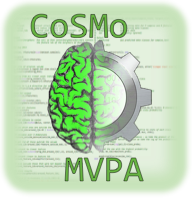run fmri correlation searchlight trivial¶
- run_up:
run_fmri_correlation_searchlight_trivial
%% Demo: fMRI searchlights with split-half correlation
%
% This is a trivial exercise as it only requires adding one line of code
%
% The output is a searchlight map showing where in the brain
% the neural patterns show category discrimination across
% six categories.
%
% The data used here is available from http://cosmomvpa.org/datadb.zip
%
% This example uses the following dataset:
% - 'ak6' is based on the following work (please cite if you use it):
% Connolly et al (2012), Representation of biological classes in the
% human brain. Journal of Neuroscience,
% doi 10.1523/JNEUROSCI.5547-11.2012
%
% Six categories (monkey, lemur, mallard, warbler, ladybug, lunamoth)
% during ten runs in an fMRI study. Using the General Linear Model
% response were estimated for each category in each run, resulting
% in 6*10=60 t-values.
%
% # For CoSMoMVPA's copyright information and license terms, #
% # see the COPYING file distributed with CoSMoMVPA. #
%% Set data paths
% The function cosmo_config() returns a struct containing paths to tutorial
% data. (Alternatively the paths can be set manually without using
% cosmo_config.)
config = cosmo_config();
ak6_study_path = fullfile(config.tutorial_data_path, 'ak6');
% show readme information
readme_fn = fullfile(ak6_study_path, 'README');
cosmo_type(readme_fn);
% reset citation list
cosmo_check_external('-tic');
% set result directory
output_path = config.output_data_path;
%% Example: split-half correlation measure (Haxby 2001-style)
%%%%%%%%%%%%%%%%%%%%%%%%%%%%%%%%%%%%%%%%%%%%%%%%%%%%%%%%%%%%%%%
% This example uses the 'ak6' dataset
% define data filenames & load data from even and odd runs
data_path = fullfile(ak6_study_path, 's01'); % data from subject s01
mask_fn = fullfile(data_path, 'brain_mask.nii'); % whole brain mask
data_odd_fn = fullfile(data_path, 'glm_T_stats_odd.nii');
ds_odd = cosmo_fmri_dataset(data_odd_fn, 'mask', mask_fn, ...
'targets', 1:6, 'chunks', 1);
data_even_fn = fullfile(data_path, 'glm_T_stats_even.nii');
ds_even = cosmo_fmri_dataset(data_even_fn, 'mask', mask_fn, ...
'targets', 1:6, 'chunks', 2);
% Combine even and odd runs
ds_odd_even = cosmo_stack({ds_odd, ds_even});
% print dataset
fprintf('Dataset input:\n');
cosmo_disp(ds_odd_even);
% Use cosmo_correlation_measure.
% This measure returns, by default, a split-half correlation measure
% based on the difference of mean correlations for matching and
% non-matching conditions (a la Haxby 2001).
measure = @cosmo_correlation_measure;
% define spherical neighborhood with radius of 3 voxels. To do so,
% assign the value 3 to a variable named 'radius'
%
% This part is the only exercise. Because it is the first exercise, it is
% supposed to be easy. The only thing to do here is to replace the
% 'Your code here' comment by the following code:
%
% radius=3
%
% Then should be able to run this script.
radius = 3; % voxels
nbrhood = cosmo_spherical_neighborhood(ds_odd_even, 'radius', radius);
% Run the searchlight with a 3 voxel radius
corr_results = cosmo_searchlight(ds_odd_even, nbrhood, measure);
% print output
fprintf('Dataset output:\n');
cosmo_disp(corr_results);
% Plot the output
cosmo_plot_slices(corr_results);
% Define output location
output_fn = fullfile(output_path, 'corr_searchlight.nii');
% Store results to disc
cosmo_map2fmri(corr_results, output_fn);
% Show citation information
cosmo_check_external('-cite');

